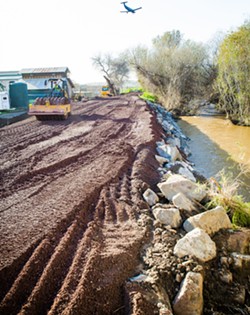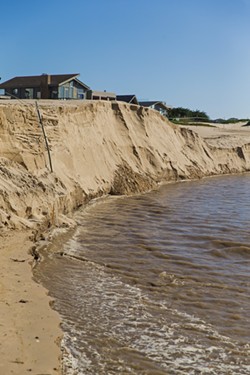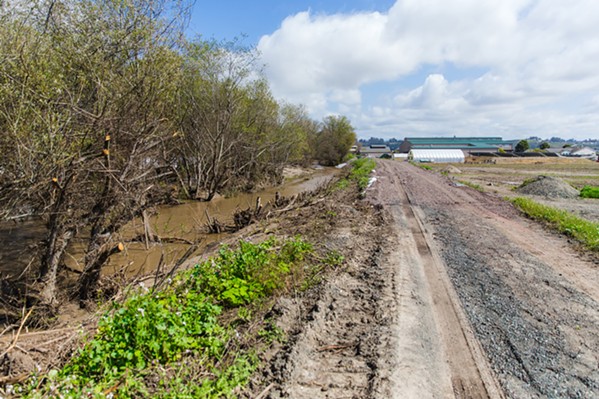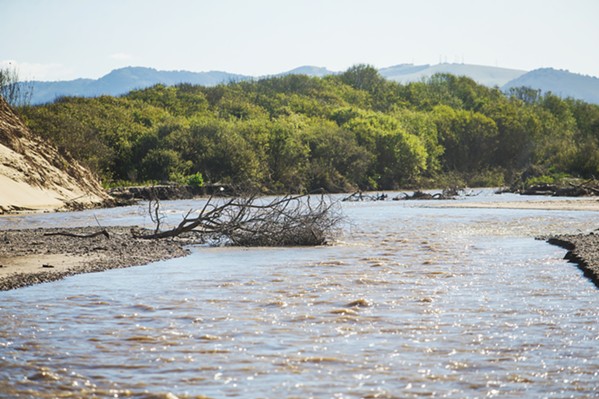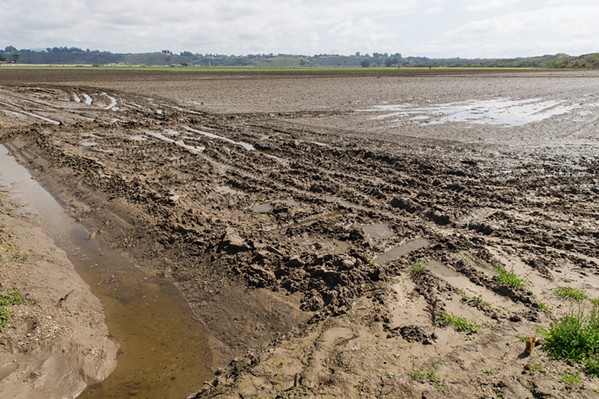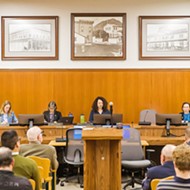When the levee breaks: Oceano residents, county officials walk a tightrope of regulations to manage Arroyo Grande Creek, which some say led to the levee's failure in January
By Bulbul Rajagopal[
{
"name": "Promo Temp Targeted",
"id": "PromoTempTargeted",
"class": "inlineCenter",
"insertPoint": "4",
"component": "15511697",
"requiredCountToDisplay": "0"
},
{
"name": "Ad - Medium Rectangle CC01 - 300x250 - Inline Content",
"class": "inlineCenter",
"insertPoint": "8",
"component": "15582119",
"requiredCountToDisplay": "12"
},{
"name": "Ad - Medium Rectangle LC01 - 300x250 - Inline Content",
"class": "inlineCenter",
"insertPoint": "18",
"component": "15582122",
"requiredCountToDisplay": "22"
},{
"name": "Ad - Medium Rectangle 9 - 300x250 - Inline Content",
"class": "inlineCenter",
"insertPoint": "28",
"component": "15582121",
"requiredCountToDisplay": "32"
}]
Oceano native Linda Austin scanned the rapidly flowing Arroyo Grande Creek as it met the Pacific Ocean after a fresh set of rainstorms on March 25.
The silty water powered through, taking out large chunks of sand from the Oceano Dunes State Vehicular Recreation Area beach, impervious to the raised clusters of knotted wood, rock, and other debris.
"The creek hasn't flowed this fast and steady in the last 25 years," Austin said. "On Feb. 28, 2001, my dad passed away. March 5, 2001, was my dad's funeral. The creek levee broke then and flooded everything."
Austin's great-grandfather moved to Oceano in 1918. Her father, Harold Guiton, was one of the few locals who actively managed the debris in the creek and influenced others to help out as well. As a little girl, Austin joined him to clear the floating scraps from the water.
"The more you clean a creek, the more you keep it flowing," Austin explained. "It's much better for the wildlife, for everything. If you're not allowed to clean it, the sediment builds up, then nothing survives, and you have a disaster like this."
The disaster she's referring to occurred when the Arroyo Grande Creek flooded into Oceano as an atmospheric river battered San Luis Obispo County in January. The storm broke on Jan. 9, dropping several inches of rain by the end of the following day. It resulted in landslides, flooded roads and homes, and two fatalities.
That big storm was the first of several in an unprecedented winter that repeatedly threatened Oceano with extreme flooding and near-constant evacuation orders. Ultimately, floodwaters not only overtopped the Arroyo Grande Creek levee on Jan. 9, but they also broke the structure that was already weakened by gopher holes and cracks.
Austin and some fellow residents believe debris that's been allowed to accumulate in the creekbed contributed to the rapid flooding, which eventually weakened the levee. The county's Public Works Department doesn't know yet why the embankment ruptured, but both local government and individuals say that a labyrinth of state regulations makes managing the creek harder.
"People like to say, 'The county doesn't do anything.' But it's not their fault," Austin said. "They're doing the best they can with the regulations that are strapped on them."
Regulated residents
Austin started clearing debris out of the Arroyo Grande Creek when she was 8 years old. At 70, she hasn't stopped.
"We were always on the tractor doing stuff," she said. "We have a hook like an anchor. I would throw it out and pull the debris out."
When she was younger, she'd use a little boat. Austin would ride to a nearby clump of debris, throw the chained hook to snag trapped logs, and back the boat out.
Age reduced her responsibilities. Austin's parents have passed away, and both her brothers have moved out of Oceano. She maintains the trees lining her section of private property along the creek and does light debris clearing while coordinating with her nephew, who does the majority of the physical labor.
According to Austin, the biggest change to how her family managed debris buildup sprung from statewide environmental regulations that banned individuals from using heavy machinery in the creek. For the Austin family, that meant retiring her father's tractor. Instead, the family would have to get into the water wearing waders and use hand tools to catch debris and pull it out.
"They called him the 'legend of Arroyo Grande Creek' because before it would rain, he'd drive his tractor down and clean it up, make sure the flood gates were open," Austin said of her father. "I think it stopped in the '80s when the regulations said no more mechanical equipment in the creek. We had to do everything by hand, and we did."
Austin is a member of the Zone 1/1A Advisory Committee—a group comprising county representatives and private landowners who live along the creek. The special district is responsible for maintaining and operating the Arroyo Grande and Los Berros creek channels for flood protection in the areas near Oceano and Arroyo Grande. Along with doing individual creek maintenance work, landowners like Austin pay an annual tax to support flood control efforts.
After January's levee breach and ensuing flood, some committee members said that although the county worked hard to get state permits to manage the levee better, it was still "under handcuffs" because state agencies didn't allow the county to thoroughly clean the debris out.
Austin said that the main issue is a clash with environmental concerns. She compared the creek and the regulations around it to the Oceano Lagoon, which old-timers like herself call "the lake." They used to hold fishing derbies there when Austin was a kid—but it's since become a cesspool, she said.
"You can't touch it; it's a quagmire of old garbage. When we were kids, they'd plant this lagoon with trout, it was alive," she said. "We need to dredge it, and you'll have the wildlife. But to just make it sit because you don't want to harm anything doesn't make sense to me."
Navigating bureaucracy
The flood control committee has roots dating back to the 1950s. During that decade, Arroyo Grande Creek experienced severe flooding that damaged the farmland in a region near Oceano Beach and Halcyon called Cienega Valley.
The damage prompted the creation of the community-led Arroyo Grande Creek Flood Control Project, which was completed in 1961. The project installed the 3.5-mile levee system that confined the creek from its confluence with Los Berros Creek downstream to the Pacific Ocean.
But the flood control channel wasn't designed to withstand significant amounts of heavy rain. The areas surrounding the creek have historically experienced flooding, and the levee previously failed in 2001.
When the flood control channel was built, it was expected to be able to handle 10,120 cubic feet per second (CFS) of water. According to the creek channel's waterway management program, that's considered a once-every-100-years event. In 1999, a U.S. Army Corps of Engineers study found that changes to the levee geometry due to settlement and erosion put the channel's capacity at 6,500 CFS.
"Maintenance activities in recent years were restricted by a combination of lack of funding (Zone 1/1A maintenance funds had not risen appreciably since the creation of the special district) and environmental concerns about the impacts of vegetation and sediment removal on aquatic and riparian habitat in the flood control reach," according to the Army Corps report.
Habitat protection concerns started in the 1990s with a confluence of interest from the California Coastal Commission, the U.S. Fish and Wildlife Service, the state Department of Fish and Wildlife, and the National Oceanic and Atmospheric Administration. These state and federal agencies wanted to create flood control strategies that also preserved the aquatic environments for the endangered California red-legged frog and steelhead trout.
Sarah Paulson, the environmental program manager of the California Department of Fish and Wildlife (CDFW), said that the permitting process for creek maintenance projects used to be "a little less formal" than it is now. Agencies tightened regulations as public interest in environmental resources increased.
CDFW has jurisdiction over activities that could substantially divert water bodies through the use or change of any material found in them.
"Stream clearing, vegetation and sediment management, and levee maintenance, all of these can happen under these [construction] permits," she said. "There are often avoidance and minimization measures associated with those permits to help reduce the impacts on some of these species."
Paulson said that while the red-legged frog is of interest to the state, the creature is on the federal list of endangered species. That means that concerns about the frog's habitat are directly handled by the U.S. Fish and Wildlife Service. However, the state still does its part by helping conserve habitat.
One of the ways the CDFW meets conservation goals is by placing an "avoidance window" on approved permits. Steelhead trout, for example, have benefited from it.
"It's timing the work when the stream is dry or when the species isn't present," Paulson explained. "We'll put a requirement in the permit that they do the work at a certain time of the year."
Through the state Fish and Game Code and the Lake and Streambed Alteration Program, CDFW issues both standard and emergency permits for construction or reconstruction work.
Under the Arroyo Grande Creek's waterway management program, that work would include vegetation and sediment management, building flood control walls to protect residences north of the flood channel, reinforcing the southside of the levee for erosion control, and raising the levee system itself to prevent future overtopping.
CDFW issues standard permits that can last up to five years. Emergency permits pertain specifically to any work that needs to be done to address an unforeseen incident or even in preparation for a disaster, such as the flooding in Oceano. Those permits, according to Paulson, don't have an expiration date, and applicants don't need to notify CDFW ahead of time. They can do so 14 days after beginning emergency work.
Paulson added that there is a public misconception that Fish and Wildlife doesn't allow people to conduct work in streams and creeks.
"It is also important to note that there is no 'denial' process in lake or streambed permitting with CDFW—proposed projects that are otherwise lawful can be permitted," she said.
Currently, there are two existing routine maintenance agreements that cover portions of Arroyo Grande, Los Berros, and Tally Ho creeks. The latter creek runs along the Tally Ho neighborhood of Arroyo Grande that has historically faced flooding.
Fish and Wildlife isn't the only agency that has its eye on the Arroyo Grande Creek. It's only one thread of a complex network of state and national groups that include the California Regional Water Quality Control Board, California Conservation Corps, U.S. Fish and Wildlife Service, and National Marine Fisheries Service under NOAA.
"When we know that there is another agency involved, a lot of times we'll do our best to reach out to them and try to coordinate to make sure none of our conditions contradict or make a project infeasible to do," Paulson said.
She added that balancing private creek management and state rules is a hot-button issue this year, especially after coming out of years of drought into one of the wettest winters in California's history.
"A lot of times stream maintenance and management is not always on the forefront of our minds," Paulson said. "But certainly this year was a big reminder that it's something we all need to work together on and ensure we can both manage the needs of the stream and fish and wildlife resources and the needs of the community to prevent unnecessary flooding."
Bridging the future
For Steph Wald, Creek Lands Conservation's watershed program manager, the dilemma of the Arroyo Grande Creek levee traces back to human settlement.
"It's not the levee breaking; it's that people developed their homes and put things in the floodplain," she said. "Floodplain is an area surrounding the creek that has high flow and becomes part of the creek, and that's what we saw happen when the levee broke: The water went everywhere, including into somebody's living room.
"These infrastructure projects have to be there now that people have built there, and that's the problem."
Creek Lands Conservation's role is to work with the community to improve conditions for both people and nature in coastal watersheds, Wald said. The nonprofit is working on a slew of watershed management plans across the Central Coast. One of them is the Arroyo Grande Creek Watershed Management Plan. Produced by Central Coast Salmon Enhancement and funded by CDFW's Fisheries Restoration
Grant Program, the plan specifically looks at critical issues affecting steelhead trout.
Wald added that the flood control channel sits at the very bottom of the Arroyo Grande Creek watershed, so the volume and velocity of the water coming down the creek from the upper regions further weakened the channel that was already struggling with decades of urbanization and climate change.
"It was built for a purpose that now is needing to be reexamined because of climate change and the fact that our rainfall patterns are changing," she said. "The amounts of water that come down into the watershed are different, and our infrastructure is not up for it, as we saw this year."
When the levee last gave way in 2001, Wald said, local authorities including the county attempted to relinquish control over it to the state Department of Water Resources.
"The state was not interested to take this project over primarily because they would have had to essentially return it to its original condition, which you can't do anymore because of regulations," Wald said. "It would be very, very, very expensive to put it back in its original form, 'as-built' in the 1960s."
That's why the flood control committee of private landowners voted in 2006 to raise their own taxes and pay to reconstruct the levee. The increased taxes resulted in a rebuilt levee, which stayed that way until it failed again this year.
But any sort of work that impacts the creek could run into hiccups during the permitting process. In 2017, the National Marine Fisheries Service held up the Arroyo Grande Waterway Management Program, stating that the project could possibly contribute to the extinction of steelhead, which were federally listed as an endangered species in 1997.
The federal agency weighed in with what's known as a "jeopardy opinion," meaning it believed that the program would reduce steelhead's likelihood of surviving in the creek. During project consultations, National Marine Fisheries Service can also issue a biological opinion, which will conclude whether the federal agency has ensured that the project is unlikely to jeopardize the existence of an endangered species and sometimes includes recommendations to further the recovery of said species.
"I talked to county Public Works people ... and said, 'How can we do a project elsewhere that would benefit steelhead and hope that the federal agency would change from a jeopardy opinion to a normal biological opinion?'" Wald said. "Every suggestion that we made, the federal agency said, 'No, that's not good enough.'"
Wald believes that flood easements in the Oceano-Arroyo Grande area that was impacted by the recent levee break could help mitigate some of the adverse effects of future big rain events. Flood easements are agreements between county officials and landowners to release water from the levee and flood farm fields during emergencies to relax the stress on the levee and prevent residential areas from being flooded.
The easement negotiation process is challenging, Wald said, because of the impacts that controlled flooding can have on prime agricultural land.
"That's expensive. If the water does go out onto a farm field, it has to then eventually drain," she said. "What's left behind on the farm field may or may not be good for farming. In other words: There's a lot of stuff in the water that isn't great."
SLO County Public Works Deputy Director Kate Ballantyne told New Times that on March 30, U.S. Sen. Alex Padilla (D-California) requested $2 million for SLO County flood easements as part of the appropriations bill for the 2024 fiscal year.
"We're happy that he's included us in his project list and hope that as it moves forward, we remain on it and can get that funding ... to get ready to implement flood easements in the best way possible," she said.
Ballantyne added that Public Works hasn't pinned down the exact reason that the levee failed in January but noted that excess stormwater runoff was a factor. She said that runoff streamed in from an urbanized upper watershed compared to the rural one that existed in 1955 when the waterway management plan was first designed.
While the levee's breach has temporarily been plugged, Public Works is now working with the Federal Emergency Management Agency to strengthen it for the future. But reinforcing existing infrastructure and building new projects are still challenges for Public Works.
Fourth District Supervisor Jimmy Paulding said that the department struggles with limited funding and staffing—something Ballantyne acknowledged too, but she added that the county is working hard to identify more grant funding and other revenue streams.
"Our county doesn't really have staff that is dedicated to pursuing state and federal grants that are intended to help our region plan for climate resilience," Paulding said. "There's a lot of money at the federal level in particular right now for those things through the Bipartisan Infrastructure Deal and the Inflation Reduction Act."
The SLO County Board of Supervisors recently directed Public Works to come up with a plan on how to build up its staffing capacity and pursue such grant opportunities. In the meantime, Arroyo Grande and Oceano residents rolled up their sleeves to help.
In late April, Paulding led a team of 10 volunteers to partially clear some of the debris in the Arroyo Grande Creek by hand. He said that the task was long overdue.
"We need sustained management and maintenance of our creeks with a vision of how to maintain them from a public safety standpoint and from an environmental protection standpoint," Paulding said. Δ
Reach Staff Writer Bulbul Rajagopal at [email protected].
Latest in News
Comments
Showing 1-1 of 1

